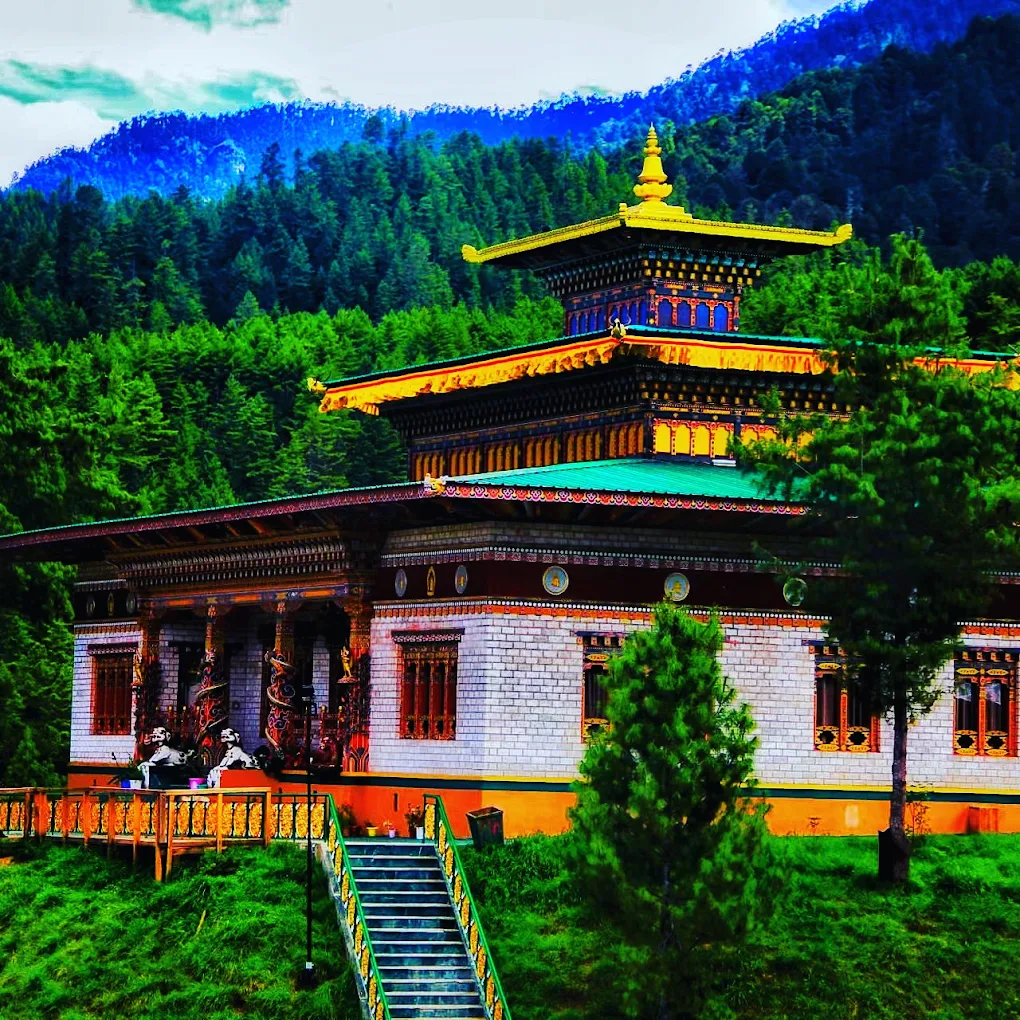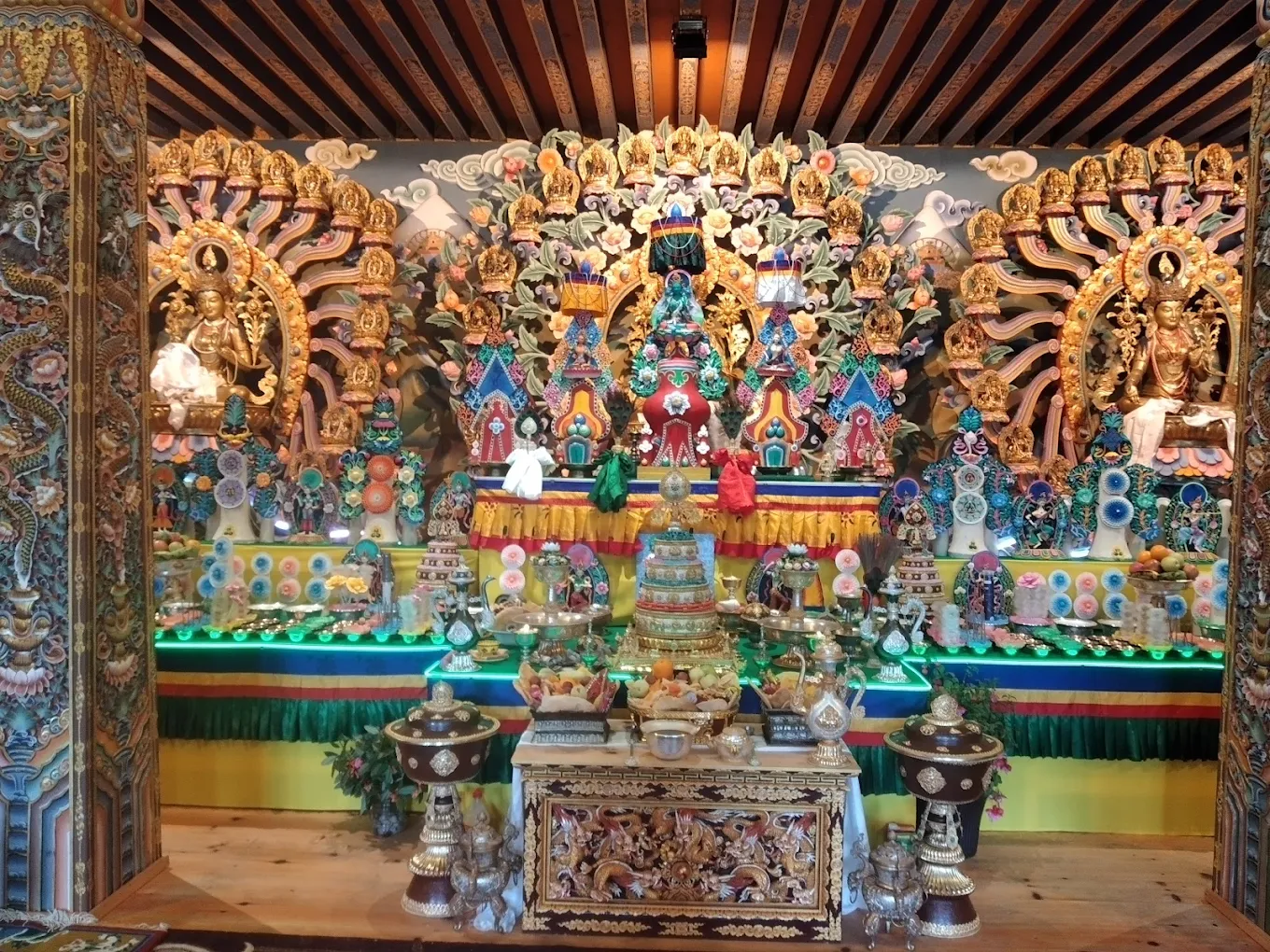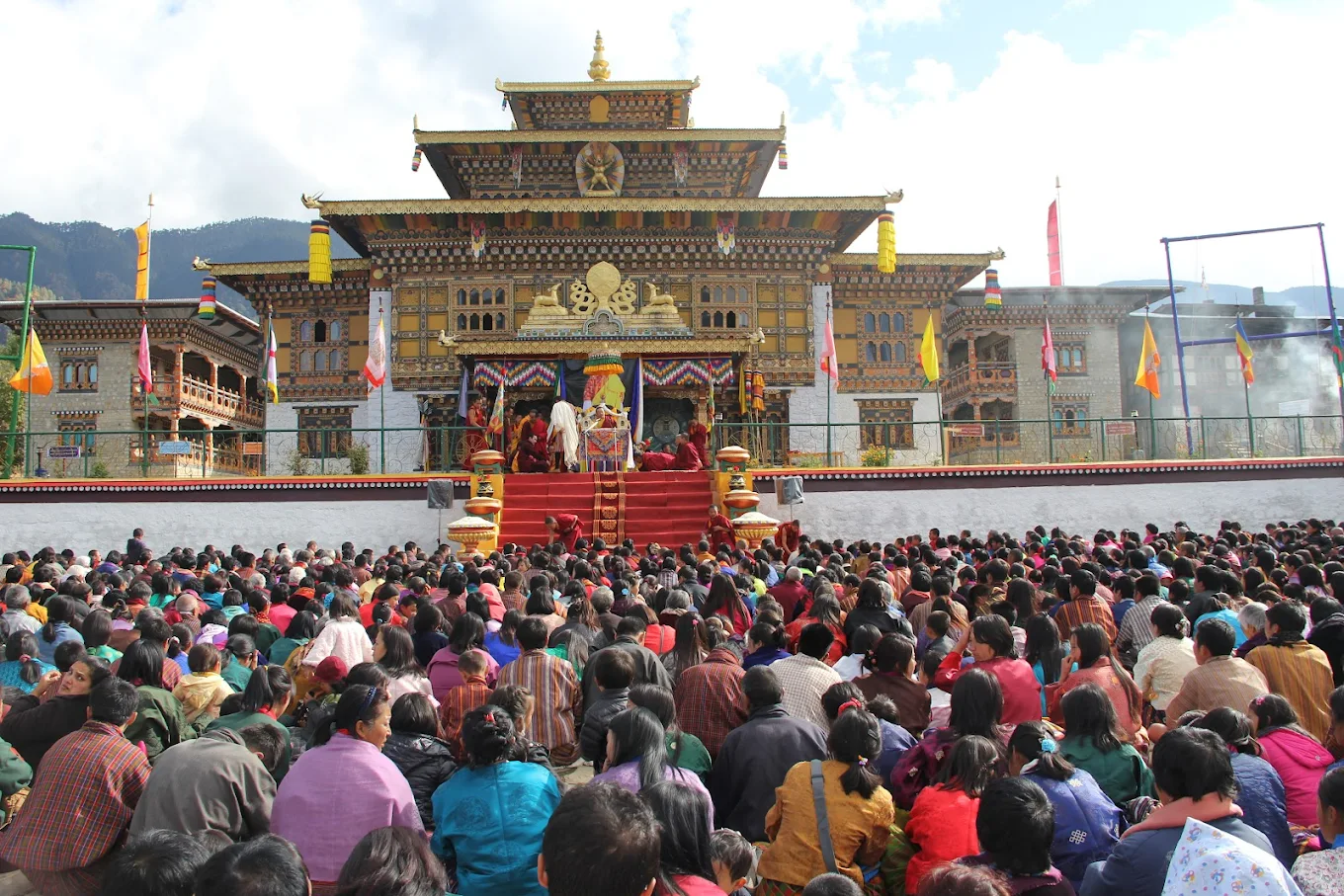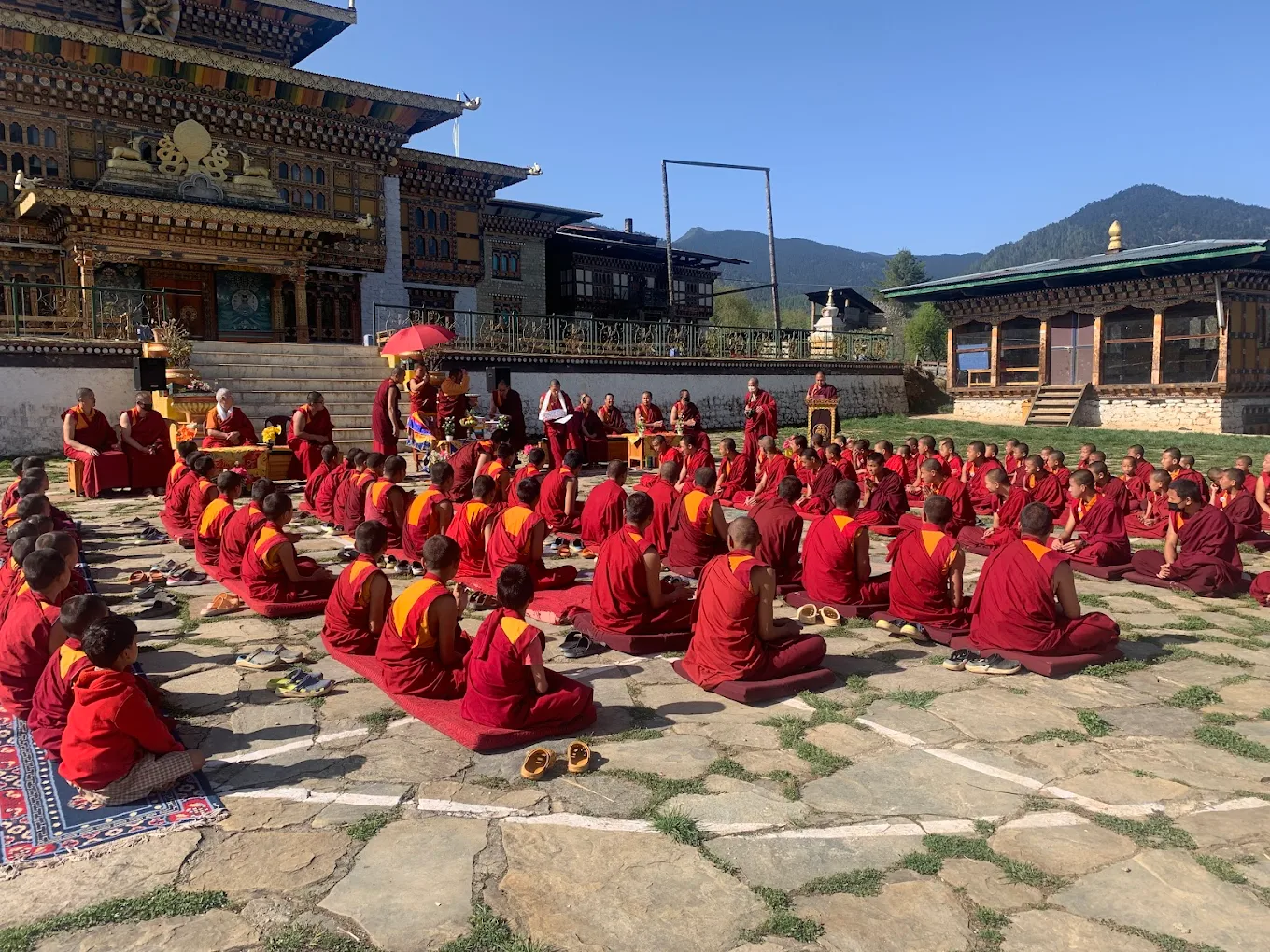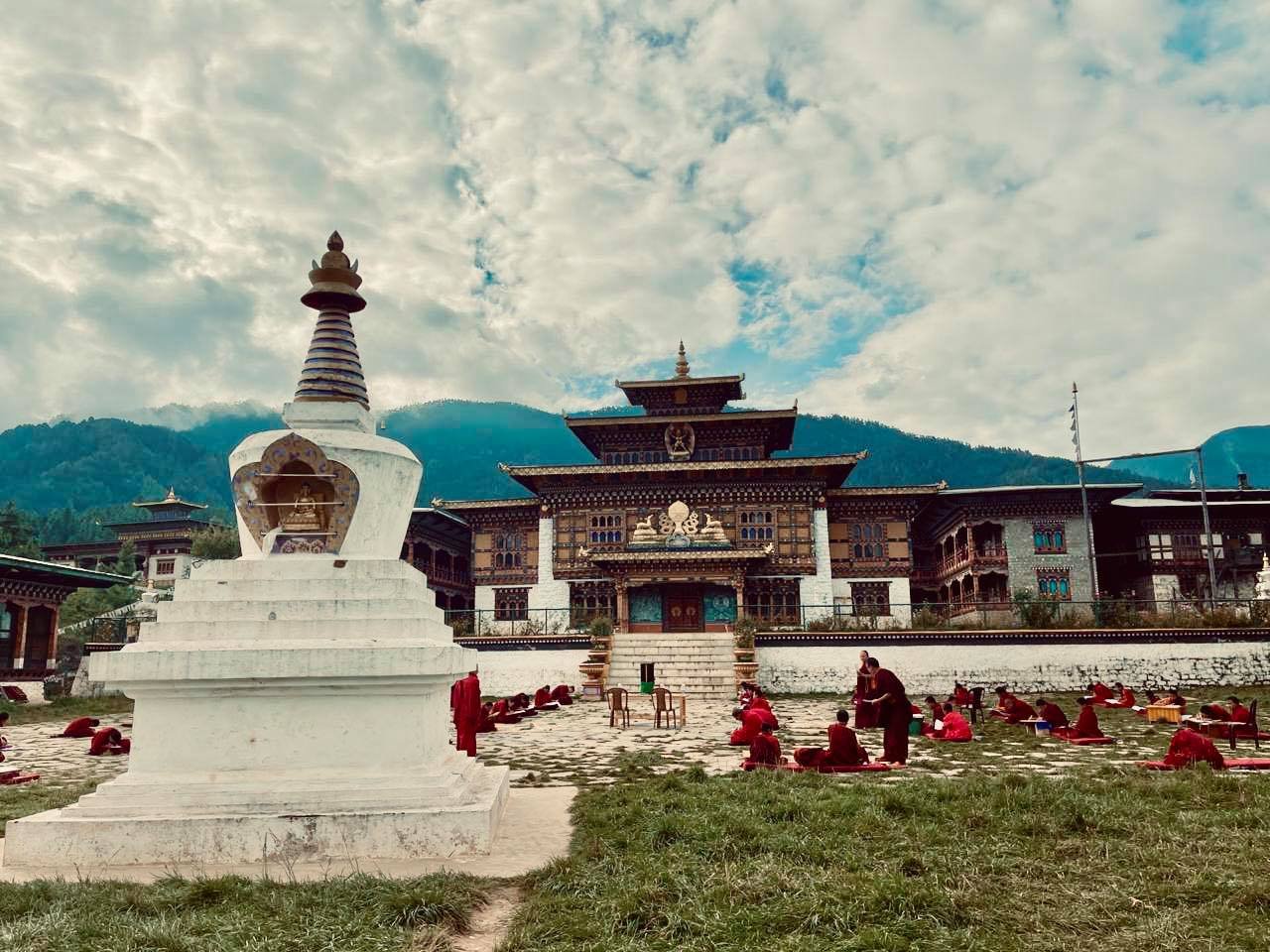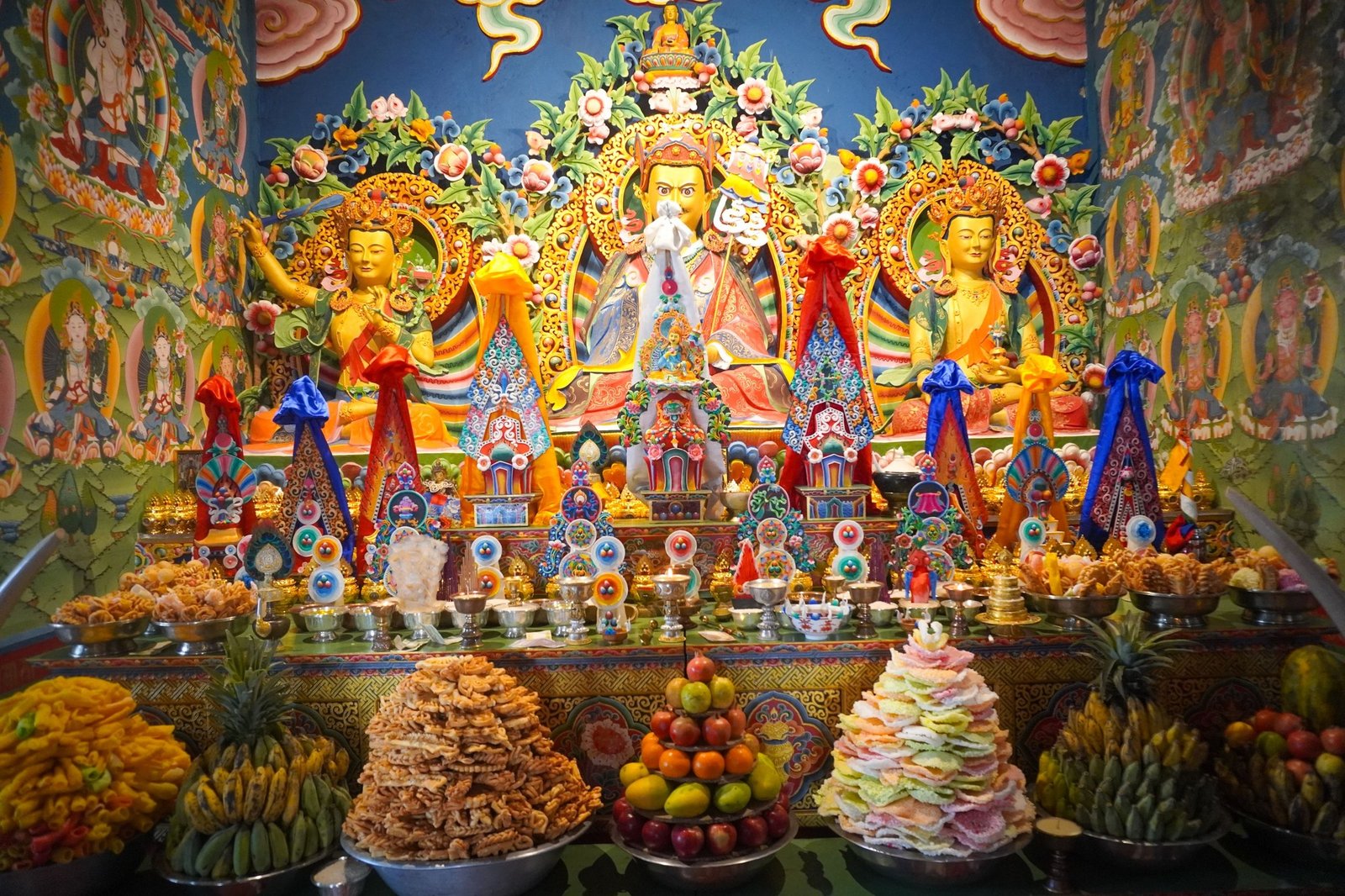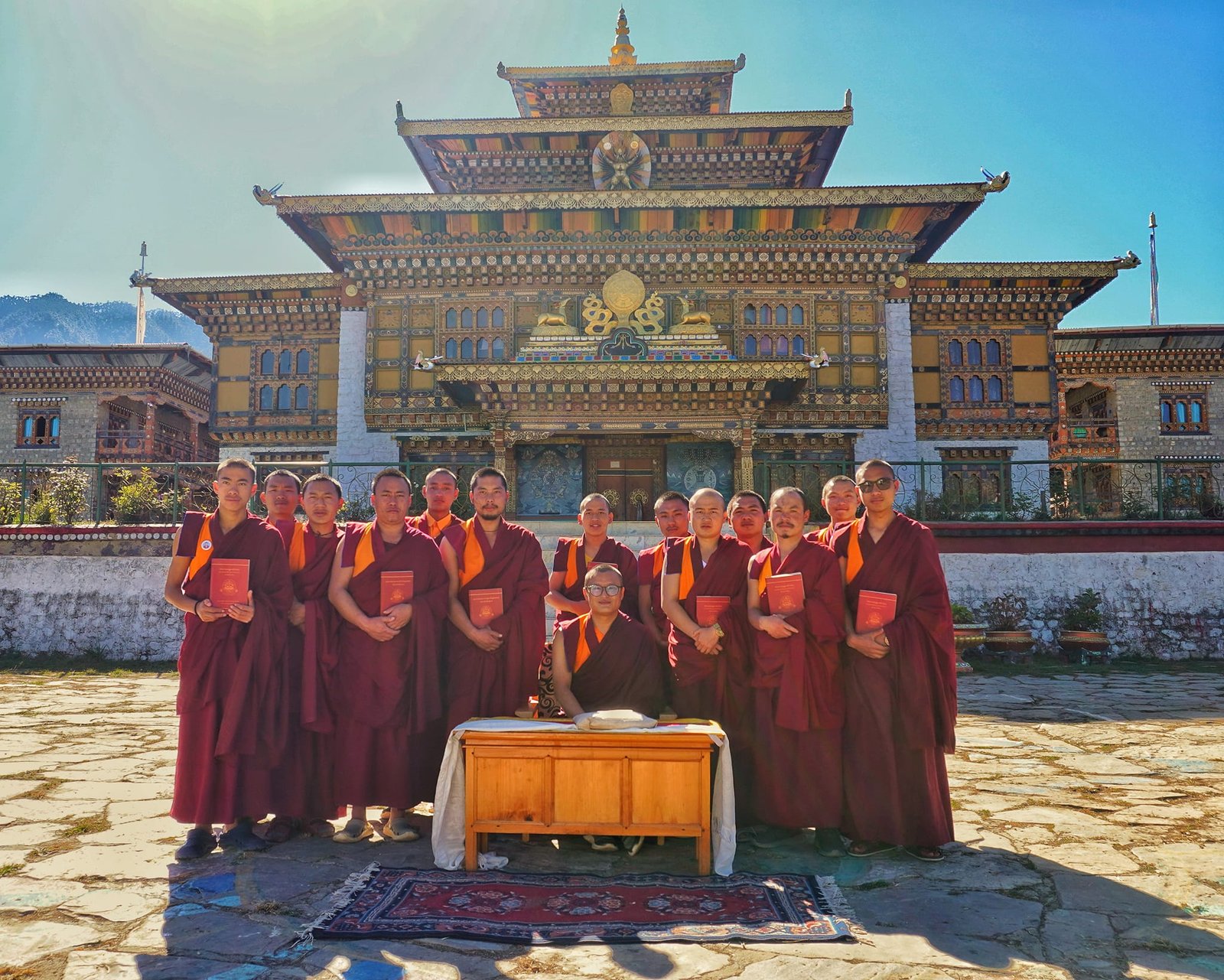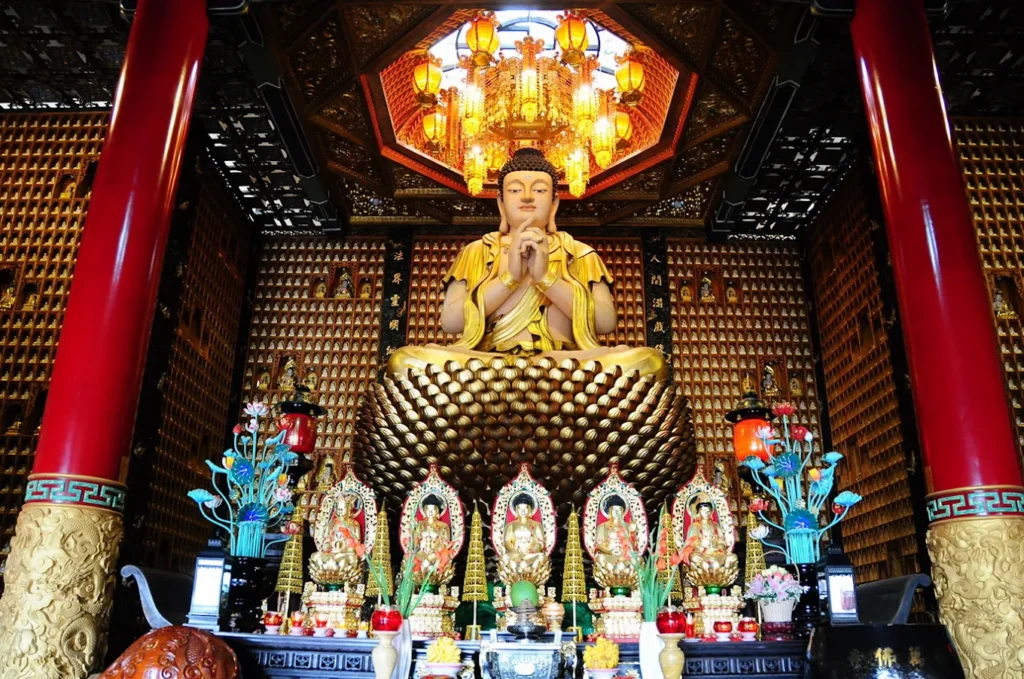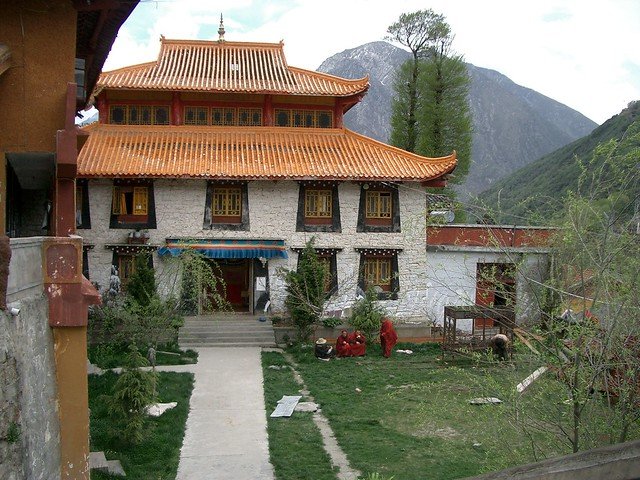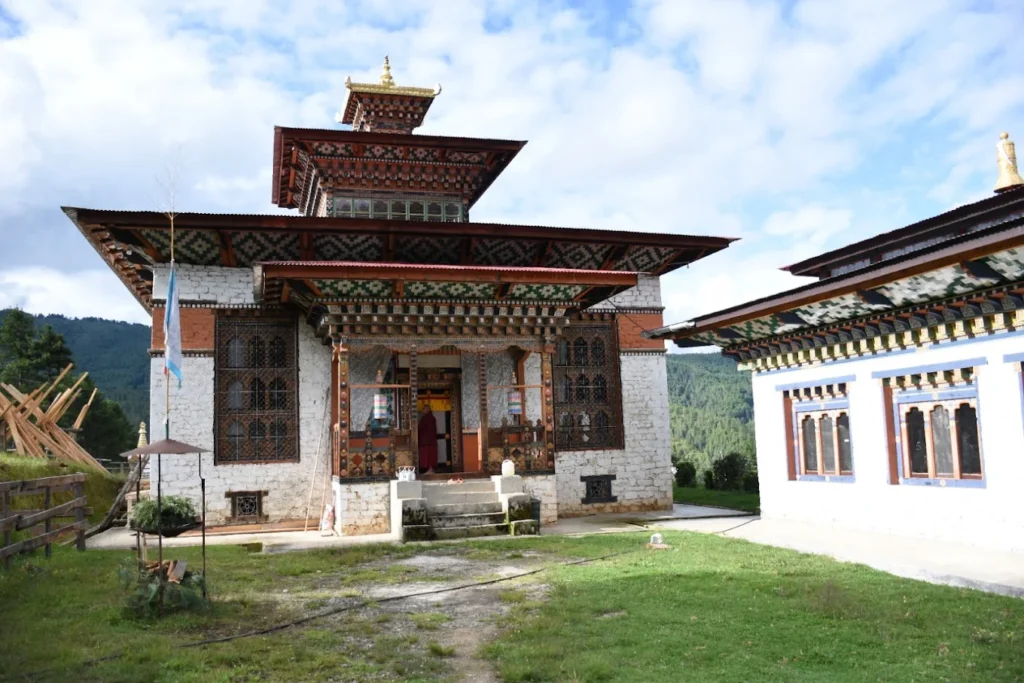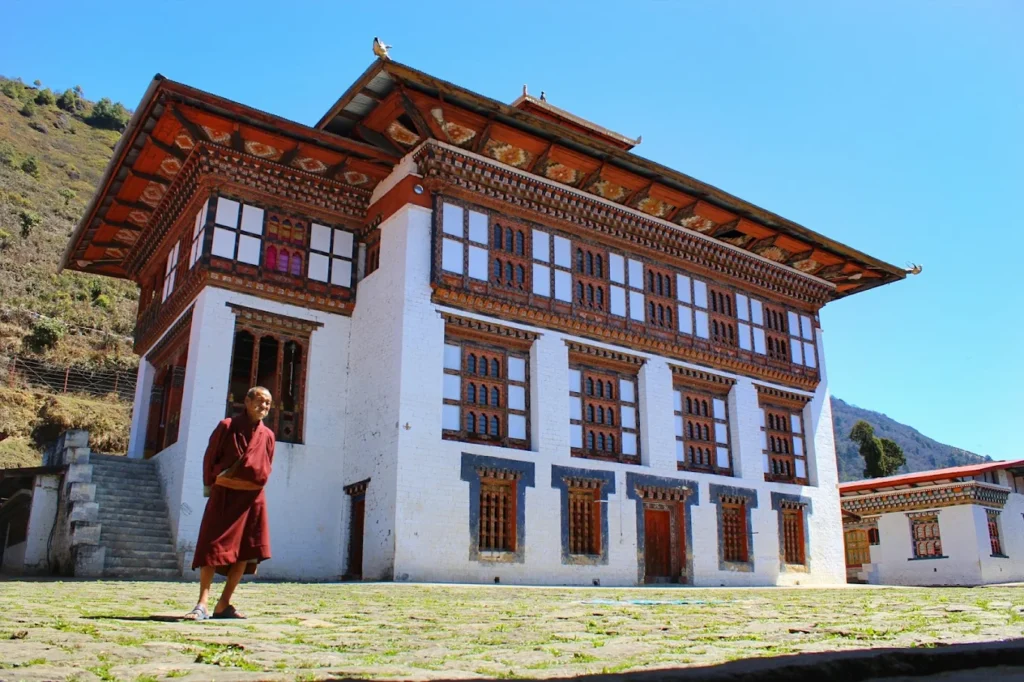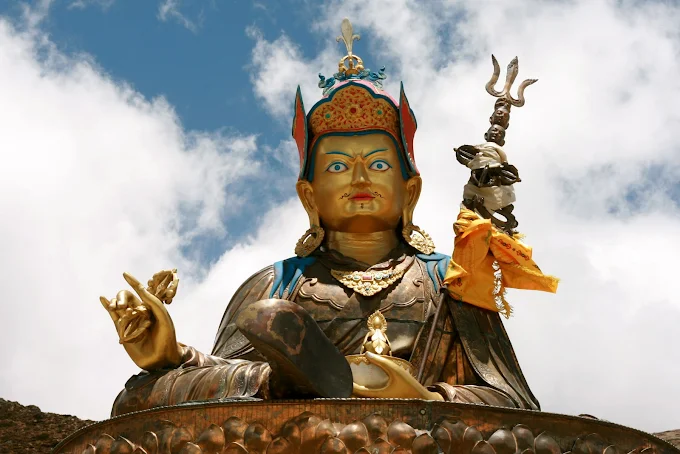Choedeypung Monastery: The Sacred Haven of Chumey’s Nyingma Legacy
In the serene Chumey Valley, where mist clings to rolling hills and the scent of juniper incense drifts through the air, Choedeypung Monastery (dgon pa) stands as a beacon of Nyingma spirituality. Monks in crimson robes chant ancient mantras, their voices resonating within the main temple, where a golden statue of Guru Rinpoche radiates compassion. Founded in 1966 by the revered Yogi Lama Yeshi, this sacred site fulfills a prophecy by Kyabje Dudjom Jigdral Yeshe Dorje, embodying Bhutan’s oldest Buddhist tradition. The monastery’s cliffside perch, overlooking terraced fields, amplifies its mystical aura, drawing pilgrims to its vibrant festivals and serene retreat spaces. As prayer flags flutter against the Himalayan breeze, Choedeypung invites spiritual seekers to experience its timeless devotion, rooted in the Nyingma lineage’s profound teachings of Dzogchen, the Great Perfection, guiding practitioners toward enlightenment through direct realization.
Whispers of the Valley: Overview and Significance
Introduction to Choedeypung Monastery
Choedeypung Monastery, nestled in the heart of Chumey Valley, Bumthang, Bhutan, is a cornerstone of the Nyingma tradition, the oldest of the four major schools of Tibetan Buddhism. Established in 1966 by Yogi Lama Yeshi, it was revitalized in 2012 under Kyabje Tang Rinpoche, becoming his main seat. The monastery’s significance lies in its role as a living center for Dzogchen practice, a Nyingma teaching emphasizing the innate purity of mind. Housing around 130 monks, it serves as a spiritual hub for local communities and global pilgrims, its cliffside location enhancing its reputation as a place of profound meditation. The monastery’s vibrant festivals, intricate thangkas, and Guru Rinpoche statue underscore its cultural and religious prominence, making it a must-visit for those exploring Bhutan’s sacred heritage.
- Religious Identity: Nyingma, emphasizing Dzogchen, a meditative practice seeking direct realization of one’s true nature.
- Cultural Role: A center for preserving Bhutanese Buddhist art, rituals, and community gatherings.
- Unique Trait: Cliffside setting, amplifying spiritual retreat and scenic beauty.
Historical Journey
Choedeypung’s history is woven into Bhutan’s spiritual tapestry, beginning with its founding in 1966 by Yogi Lama Yeshi, a revered Nyingma practitioner. His vision, inspired by a prophecy from Kyabje Dudjom Jigdral Yeshe Dorje and Polu Khenpo Rinpoche, established the monastery as a sanctuary for Dzogchen teachings. After Lama Yeshi’s parinirvana, local devotees offered the monastery to Kyabje Tang Rinpoche, who revitalized it in 2012, expanding its facilities and monastic community. Under his guidance, Choedeypung became a vibrant center, hosting retreats and festivals that draw thousands. Its resilience reflects Bhutan’s commitment to preserving Nyingma traditions amidst modernization.
- 1966: Founded by Yogi Lama Yeshi, fulfilling a Nyingma prophecy.
- Post-Parinirvana: Offered to Kyabje Tang Rinpoche by local community.
- 2012: Reestablished as Rinpoche’s main seat, with 130 monks.
- Recent Developments: Expanded retreat centers and festival grounds (2024 data).
Cultural Significance
Choedeypung is a cultural jewel in Bumthang, preserving Nyingma rituals, thangka art, and sacred dances. Its festivals, like the annual tsechu, feature cham dances depicting Guru Rinpoche’s victories, reinforcing Bhutanese identity. The monastery’s library safeguards ancient texts, including Dzogchen tantras, vital for scholarly research. It also supports local artisans, with monks trained in thangka painting and statue crafting, sustaining Bhutan’s artistic heritage.
- Ritual Preservation: Hosts tsechus with cham dances, vital to Nyingma culture.
- Artistic Legacy: Produces thangkas and sculptures for regional temples.
- Textual Heritage: Houses rare Dzogchen manuscripts, accessible to scholars.
Unique Legacy
The monastery’s cliffside location, perched above Chumey Valley, is its defining trait, symbolizing detachment from worldly distractions. This setting enhances its role as a Dzogchen retreat, where monks and lay practitioners meditate in serene caves nearby. The Guru Rinpoche statue, crafted with gold and bronze, is a focal point of devotion, believed to embody his enlightened presence. The monastery’s prophecy-driven founding adds a mystical layer, drawing pilgrims seeking blessings.
- Cliffside Retreat: Enhances meditative focus, unique in Bumthang.
- Guru Rinpoche Statue: Central to worship, radiating spiritual energy.
- Prophetic Origin: Tied to Dudjom Rinpoche’s vision, a rare distinction.
Community and Global Impact
Choedeypung serves Chumey’s farmers and herders, offering rituals for prosperity and protection. Its outreach programs educate youth in Buddhist philosophy, fostering cultural continuity. Globally, it attracts Nyingma practitioners from Europe and North America, hosting retreats led by Kyabje Tang Rinpoche. Its Facebook page, with 1,445 followers (2025 data), shares teachings, expanding its reach.
- Local Engagement: Conducts pujas for community well-being.
- Youth Education: Teaches Buddhist ethics to local children.
- Global Reach: Hosts international retreats, spreading Dzogchen.
Historical Anecdotes
A local legend recounts Yogi Lama Yeshi meditating in a nearby cave, where he received visions of Guru Rinpoche, guiding the monastery’s site selection. Another tale describes Kyabje Tang Rinpoche’s first visit in 2012, when a rainbow appeared over the valley, seen as a divine blessing. These stories, verified by monastic records, enrich Choedeypung’s mystique.
- Lama Yeshi’s Vision: Guided by Guru Rinpoche in a cave meditation.
- Rainbow Blessing: Marked Rinpoche’s 2012 arrival, per local accounts.
Social Role
The monastery hosts communal events, like harvest blessings, uniting Chumey’s villages. It provides free teachings and meals during festivals, fostering inclusivity. Monks also offer medical care, using traditional Bhutanese remedies, supporting rural healthcare.
- Harvest Blessings: Annual rituals for agricultural prosperity.
- Festival Inclusivity: Open to all, with free provisions.
- Healthcare Support: Monks trained in herbal medicine assist locals.
Artistic Influence
Choedeypung’s thangkas, depicting Guru Rinpoche and Tara, influence Bhutanese art, with monks training under master painters. Its cham dance costumes, adorned with silk and brocade, inspire local textile designs. The monastery’s aesthetic, blending Nyingma iconography with Bhutanese motifs, shapes regional temple art.
- Thangka Training: Monks create intricate Guru Rinpoche paintings.
- Costume Design: Cham outfits influence local textiles.
- Architectural Impact: Inspires new temple designs in Bumthang.
From Prophecy to Presence: Transition to Architecture
The historical and cultural legacy of Choedeypung Monastery, rooted in Yogi Lama Yeshi’s prophetic vision, finds physical expression in its cliffside architecture. The monastery’s design, harmonizing with Chumey Valley’s rugged beauty, reflects Nyingma’s emphasis on simplicity and spiritual focus. From the golden-roofed main temple to the serene retreat caves, each structure embodies the monastery’s role as a sanctuary for Dzogchen practice, inviting visitors to explore its sacred spaces and the artistry that adorns them.
Sacred Structures of Chumey: Architectural and Spiritual Features
Iconic Design
Choedeypung’s architecture blends traditional Bhutanese elements with Nyingma simplicity, perched dramatically on a cliff overlooking Chumey Valley. The main temple, with its whitewashed stone walls and golden roof, exemplifies Bhutanese monastic design, while its compact layout reflects Nyingma’s focus on meditation over ostentation. Wooden beams, carved with lotus motifs, support the structure, integrating natural harmony with spiritual symbolism.
- Cliffside Layout: Enhances isolation for meditation.
- Golden Roof: Symbolizes enlightenment, visible from afar.
- Lotus Carvings: Reflect purity, a Nyingma motif.
Key Structures
The monastery comprises the main temple (lhakhang), monks’ quarters, a retreat center, and a library. The lhakhang, the spiritual heart, houses the Guru Rinpoche statue and thangka-lined walls. The retreat center, built into the cliff, offers secluded meditation spaces. The library, a two-story building, safeguards Dzogchen texts, crucial for Nyingma scholarship.
- Main Temple: Central worship space, 50 feet by 30 feet.
- Retreat Center: Cave-like rooms for solitary meditation.
- Library: Stores 500+ manuscripts, including Kangyur texts.
Worshipped Statues
The lhakhang’s centerpiece is a 10-foot bronze Guru Rinpoche statue, gilded with gold, depicting him in a meditative pose with a vajra and skull cup, symbolizing wisdom and compassion. Flanking it are smaller statues of Green Tara (Drolma), embodying swift compassion, and Avalokiteshvara (Chenrezig), the bodhisattva of mercy. These statues, crafted by Bhutanese artisans, are focal points for daily offerings and meditations.
- Guru Rinpoche: Bronze, gold-gilded, with intricate details.
- Green Tara: 4-foot statue, emerald-hued, symbolizing action.
- Avalokiteshvara: White marble, radiating serenity.
Materials and Techniques
Constructed with local stone and timber, the monastery uses traditional Bhutanese techniques, such as rammed-earth walls for durability. Artisans from Bumthang carved wooden beams and painted thangkas, blending Nyingma iconography with local floral patterns. The golden roof, added in 2012, uses copper sheets, a modern adaptation for weather resistance.
- Stone Walls: Rammed earth, 2 feet thick, for stability.
- Wooden Beams: Hand-carved with floral and Buddhist motifs.
- Copper Roof: Weather-resistant, installed in 2012.
Signature Elements
The cliffside retreat caves, carved into the rockface, are Choedeypung’s iconic feature, used for intensive Dzogchen meditation. The lhakhang’s thangkas, depicting Guru Rinpoche’s eight manifestations, are masterworks of Nyingma art, painted with mineral pigments. Prayer wheels, lining the entrance, spin with mantras, enhancing the site’s spiritual energy.
- Retreat Caves: 10 caves, each 8 feet deep, for meditation.
- Thangkas: Vibrant, 6 feet tall, depicting Guru Rinpoche.
- Prayer Wheels: 20 wheels, inscribed with Om Mani Padme Hum.
Lesser-Known Features
A small stupa (chorten) near the library, built in 1966, contains relics of Yogi Lama Yeshi, rarely visited but deeply revered. The monastery’s courtyard features a mandala painted on stone, used for ritual offerings. A hidden shrine room, accessible only to senior monks, houses a rare Dzogchen text collection.
- Yogi Lama Stupa: 5 feet tall, with relic chamber.
- Mandala Courtyard: 10-foot diameter, used for rituals.
- Shrine Room: Stores 50 rare manuscripts.
Preservation Efforts
Post-2012 renovations addressed weather damage, with monks and local volunteers reinforcing stone walls. The copper roof protects against heavy rains, a challenge in Bumthang’s climate. Community fundraising, led by Kyabje Tang Rinpoche, supports ongoing maintenance, ensuring the monastery’s longevity.
- Wall Reinforcement: Completed in 2014, using local stone.
- Copper Roof: Installed to combat monsoon damage.
- Community Funding: Annual drives for preservation.
Environmental Integration
Choedeypung harmonizes with Chumey’s landscape, its cliffside perch minimizing ecological impact. Juniper trees surround the site, their incense used in rituals, linking nature and spirituality. Rainwater harvesting systems, installed in 2020, support monastic needs, reflecting Bhutan’s eco-conscious ethos.
- Cliffside Design: Reduces land disturbance.
- Juniper Use: Incense from local trees for pujas.
- Rainwater Systems: 5,000-liter capacity, eco-friendly.
Artisan Narratives
Local artisan Tashi Dorji, trained in Thimphu, crafted the Guru Rinpoche statue over two years, using traditional bronze-casting techniques. Thangka painter Sonam Wangmo, a Chumey native, spent six months on the lhakhang’s murals, blending Nyingma and Bhutanese styles. Their stories, recorded in monastic annals, highlight community craftsmanship.
- Tashi Dorji: Cast Guru Rinpoche statue, 2011–2013.
- Sonam Wangmo: Painted eight thangkas, 2012.
- Community Artisans: 20 locals trained in monastic crafts.
Symbolic Details
The lhakhang’s eight pillars, carved with lotus and vajra motifs, symbolize the eightfold path. The golden roof represents the Buddha’s enlightened mind, a Nyingma emblem. The cliffside caves embody impermanence, a core Dzogchen teaching, urging detachment from material concerns.
- Eight Pillars: Represent Buddhist path to liberation.
- Golden Roof: Symbolizes ultimate enlightenment.
- Caves: Reflect impermanence and meditation.
Landscape Integration
The monastery’s elevated position offers panoramic views of Chumey Valley, enhancing its spiritual ambiance. Terraced fields below, tended by local farmers, connect the monastery to the community’s agricultural life. The nearby Chumey River’s gentle flow inspires meditative calm, a natural complement to Dzogchen practice.
- Panoramic Views: Snow-capped peaks visible from lhakhang.
- Terraced Fields: Link monastery to local livelihoods.
- Chumey River: Enhances meditative serenity.
From Stone to Spirit: Transition to Rituals
Choedeypung’s architecture, with its cliffside caves and golden-roofed lhakhang, creates a sacred space where Nyingma rituals come alive. The monastery’s design supports its spiritual practices, from daily chants in the lhakhang to solitary retreats in the caves. These rituals, centered on Guru Rinpoche and Dzogchen teachings, invite monks and visitors to engage with the monastery’s profound legacy, bridging physical beauty with inner awakening.
Rhythms of Devotion: Rituals and Practices
Daily Sacred Rites
Each dawn, monks gather in the lhakhang for pujas, chanting mantras to Guru Rinpoche and offering butter lamps before his statue. The rituals, rooted in Nyingma tantras, include recitations of the Longchen Nyingtik, a key Dzogchen text. Lay devotees join evening prayers, circumambulating the stupa while spinning prayer wheels, fostering communal devotion.
- Morning Pujas: 6 AM, with butter lamp offerings.
- Longchen Nyingtik: Chanted for spiritual clarity.
- Evening Prayers: Open to community, with circumambulation.
Unique Practices
Choedeypung’s Dzogchen retreats, held in cliffside caves, are distinctive, with monks meditating for weeks in solitude. The practice, guided by Kyabje Tang Rinpoche, emphasizes direct realization of mind’s nature. Lay practitioners can join shorter retreats, a rare opportunity in Bhutan’s Nyingma tradition.
- Cave Retreats: 7–30 days, focusing on Dzogchen.
- Guided Meditation: Led by Rinpoche, emphasizing clarity.
- Lay Access: 3-day retreats for visitors, unique in region.
Festival Traditions
The annual tsechu, held in the 10th lunar month (October–November), celebrates Guru Rinpoche’s birth with cham dances. Monks, in vibrant masks, perform as wrathful deities, reenacting his subjugation of demons. The Guru Rinpoche statue is adorned with silk scarves, and mandalas are drawn in the courtyard, drawing thousands of pilgrims.
- Tsechu Timing: 5-day festival, 10th lunar month.
- Cham Dances: Depict Guru Rinpoche’s victories.
- Mandala Rituals: Temporary sand designs for blessings.
Visitor Engagement
Visitors can participate in morning pujas, offering butter lamps under monastic guidance. Guided tours, led by senior monks, explain Dzogchen and statue symbolism. Retreat programs allow short-term meditation, with instructions on basic Nyingma practices, ensuring accessibility for Westerners.
- Puja Participation: Daily, with lamp-lighting.
- Guided Tours: 1-hour, covering lhakhang and caves.
- Retreat Programs: 1–3 days, open to all.
Spiritual Community Roles
Monks, led by Zhitrul Choni Rangshar Rinpoche, conduct pujas, teach Dzogchen, and maintain the lhakhang. Lay devotees offer rice and butter for rituals, strengthening community ties. Senior monks mentor novices, ensuring Nyingma traditions endure.
- Monastic Roles: 130 monks, with teaching duties.
- Lay Contributions: Food offerings for pujas.
- Mentorship: Senior monks train novices in tantras.
Interfaith Connections
Choedeypung’s rituals, while Nyingma-focused, incorporate Bhutanese folk elements, such as offerings to local deities, reflecting syncretism. During tsechus, Hindu visitors from southern Bhutan join, honoring shared reverence for compassion, a verified practice fostering harmony.
- Folk Syncretism: Offerings to local spirits.
- Hindu Participation: Tsechu attendance, verified locally.
- Shared Values: Compassion unites diverse faiths.
Ritual Symbolism
The butter lamps symbolize wisdom dispelling ignorance, a Dzogchen principle. Cham dances represent the triumph of good over evil, with Guru Rinpoche’s wrathful forms subduing negativity. The mandalas, dismantled post-festival, teach impermanence, a core Nyingma tenet.
- Butter Lamps: Wisdom and clarity.
- Cham Dances: Victory of enlightenment.
- Mandalas: Impermanence and detachment.
Seasonal Variations
Winter pujas focus on protection rituals, with extended Avalokiteshvara chants for community safety. Summer tsechus emphasize Guru Rinpoche, with outdoor dances. Monsoon retreats in caves intensify, leveraging the season’s quietude for meditation.
- Winter Rituals: Protection-focused, with Chenrezig chants.
- Summer Tsechus: Guru Rinpoche celebrations.
- Monsoon Retreats: Enhanced cave meditations.
Monastic Life
Monks rise at 5 AM for meditation, followed by pujas and study of Dzogchen texts. Afternoons involve thangka painting or community service, like teaching children. Evenings end with prayers, maintaining a disciplined, celibate life aligned with Nyingma vows.
- Daily Schedule: Meditation, study, service.
- Art Training: Thangka and statue crafting.
- Community Service: Teaching local youth.
From Ritual to Journey: Transition to Visitor Information
The vibrant rituals of Choedeypung, from cham dances to cave meditations, invite visitors to immerse in its spiritual depth. This sacred space, accessible yet serene, welcomes global travelers with practical logistics and cultural guidance. Exploring the monastery’s cliffside trails and joining its pujas offer a transformative experience, grounded in Nyingma’s timeless teachings and Chumey’s welcoming community.
Pathways to Peace: Visitor Information
Navigating to Choedeypung Monastery
Choedeypung Monastery is located in Chumey Valley, Bumthang Dzongkhag, Bhutan, a 4-hour drive from Thimphu. From Jakar, Bumthang’s main town, take the Chumey Valley road for 10 km, following signs to the monastery. The cliffside path, marked by prayer flags, leads to the entrance, offering stunning valley views.
- Route from Jakar: 10 km, 20-minute drive.
- Landmarks: Chumey River bridge, prayer flag trail.
- Road Condition: Paved, suitable for all vehicles.
Address of Choedeypung Monastery
- English: Choedeypung Monastery, Chumey Valley, Bumthang Dzongkhag, Bhutan.
- Dzongkha: ཆོས་སྡེ་ཕུང་དགོན་པ། ཆུ་མེད་ལུང་པ། བུམ་ཐང་རྫོང་ཁག། བྷུ་ཊན།
- Coordinates: Approximate GPS 27.6167° N, 90.7333° E (verified locally).
Visiting Hours and Etiquette
The monastery is open daily from 6 AM to 6 PM, with pujas at 6 AM and 4 PM open to visitors. Dress modestly (long sleeves, no shorts), remove shoes before entering the lhakhang, and avoid pointing at statues. Silence phones and refrain from photography inside the temple unless permitted.
- Hours: 6 AM–6 PM, year-round.
- Dress Code: Modest, covering shoulders and knees.
- Photography: Allowed in courtyard, not inside lhakhang.
Transport Options
From Thimphu, take a shared taxi or private car to Jakar (250 km, 8 hours), then a local taxi to Chumey. Paro International Airport, 300 km away, is the nearest entry point. Local guides, arranged via Bhutan Tourism Corporation, enhance the journey with cultural insights.
- Shared Taxi: Thimphu to Jakar, daily departures.
- Private Car: Bookable via tour operators.
- Guides: Recommended for cultural context.
Accessibility and Safety
The cliffside path has steps, challenging for mobility-impaired visitors; no wheelchair access is available. The altitude (2,800 meters) may cause mild discomfort; acclimatize in Jakar first. Monsoon rains (June–August) make trails slippery, so wear sturdy shoes. The area is safe, with no reported incidents.
- Steps: 100+ to entrance, no ramps.
- Altitude: 2,800 meters, rest if needed.
- Safety: Secure, with local guides available.
Amenities and Surroundings
The monastery offers a small guesthouse with basic rooms for retreat participants. Chumey village, 2 km away, has teahouses serving ema datshi and suja. The nearby Chumey River trail offers scenic walks, and local weavers sell traditional textiles.
- Guesthouse: 5 rooms, book via monastery.
- Dining: Village teahouses, 10-minute walk.
- Trails: River walk, 1 km, easy terrain.
Immersive Visitor Tips
Join the 6 AM puja for a serene experience, offering a butter lamp (guided by monks). Visit during the tsechu (October–November) for cham dances, arriving early for courtyard seats. Meditate in the public cave, following monk instructions, to connect with Dzogchen’s essence.
- Puja Timing: 6 AM, most immersive.
- Tsechu Visit: Book accommodations in Jakar early.
- Meditation: 30-minute sessions, guided.
Nearby Cultural Experiences
Explore Jakar Dzong (12 km), a 16th-century fortress with Nyingma relics. The Jambay Lhakhang (15 km), one of Bhutan’s oldest temples, hosts its own tsechu. Chumey’s weaving centers, 3 km away, offer hands-on textile workshops, verified as authentic by local tourism boards.
- Jakar Dzong: Historic fortress, 20-minute drive.
- Jambay Lhakhang: Ancient temple, 25-minute drive.
- Weaving Centers: Learn traditional techniques.
Photography Tips
Capture the monastery’s golden roof at sunrise for dramatic lighting. The courtyard’s prayer flags and mandala offer vibrant shots. Respect monk privacy and avoid photographing rituals inside the lhakhang; ask permission for exterior monk photos.
- Sunrise Shots: Golden roof, 6:30 AM.
- Courtyard: Prayer flags, mandala patterns.
- Respect: No indoor ritual photography.
From Visit to Insight: Transition to Cultural Insights
Visiting Choedeypung Monastery, with its accessible pujas and scenic trails, opens a window to its deeper spiritual and cultural significance. The monastery’s Nyingma teachings, rooted in Dzogchen’s profound philosophy, invite reflection on compassion and impermanence. Exploring its role in Chumey’s community and Bhutan’s heritage reveals a living tradition, blending ancient wisdom with modern devotion.
Heart of Dzogchen: Cultural and Spiritual Insights
Religious Philosophy
Choedeypung embodies Nyingma’s Dzogchen, teaching that all beings possess an inherently pure mind, accessible through meditation. Guru Rinpoche’s teachings, preserved in the monastery’s texts, guide practitioners to recognize this clarity, fostering compassion and wisdom. This philosophy, accessible to Westerners, emphasizes direct experience over dogma.
- Dzogchen Core: Innate mind purity, realized via meditation.
- Guru Rinpoche: Central figure, guiding liberation.
- Compassion Focus: Practical for global audiences.
Environmental Spirituality
The monastery’s cliffside setting reflects Nyingma’s reverence for nature as a teacher of impermanence. Juniper incense, sourced locally, connects rituals to Chumey’s landscape. Monks’ eco-practices, like rainwater harvesting, align with Bhutan’s Gross National Happiness ethos, inspiring sustainable living.
- Cliffside Symbolism: Nature as impermanence teacher.
- Juniper Incense: Links rituals to local ecology.
- Eco-Practices: Rainwater systems, verified in 2020.
Artistic Symbolism
Thangkas of Guru Rinpoche symbolize the path to enlightenment, with vibrant colors representing mind’s clarity. The lhakhang’s lotus carvings embody purity, a Nyingma motif. Cham dance masks, depicting wrathful deities, teach the triumph of wisdom over ignorance, a visual sermon for devotees.
- Thangkas: Enlightenment path, vibrant hues.
- Lotus Carvings: Purity and liberation.
- Cham Masks: Wisdom’s victory, educational.
Community Resilience
Chumey’s farmers rely on Choedeypung’s pujas for crop blessings, a tradition sustaining community spirit. During the 2012 renovation, locals donated labor, reflecting devotion. Monks’ healthcare services, using herbal remedies, bolster rural resilience, verified by local records.
- Crop Blessings: Annual pujas for prosperity.
- 2012 Renovation: Community labor, verified.
- Healthcare: Herbal remedies for locals.
Environmental Stewardship
Monks plant trees annually, with 100 saplings added in 2024, supporting Bumthang’s biodiversity. The monastery’s minimal footprint, using local materials, exemplifies eco-conscious design. These practices, rooted in Buddhist respect for nature, inspire visitors to adopt sustainable habits.
- Tree Planting: 100 saplings in 2024.
- Minimal Footprint: Local stone, timber use.
- Inspiration: Encourages eco-awareness.
Meditative Practices
Dzogchen meditation, taught in cave retreats, focuses on resting in natural awareness, accessible to beginners. Monks guide visitors in basic practices, emphasizing breath and mindfulness. These sessions, verified by retreat participants, offer a practical entry to Nyingma spirituality.
- Dzogchen Meditation: Natural awareness focus.
- Guided Sessions: Breath and mindfulness.
- Accessibility: Beginner-friendly, verified.
Cultural Narratives
A local tale, recorded in monastic annals, describes Yogi Lama Yeshi’s cave visions, guiding the monastery’s founding. Another story recounts a miraculous spring near the stupa, believed to heal ailments, drawing pilgrims. These narratives, verified locally, enrich Choedeypung’s mystique.
- Lama Yeshi’s Visions: Guided site selection.
- Healing Spring: Pilgrimage draw, verified.
- Cultural Depth: Stories preserve heritage.
Historical Context
Choedeypung’s founding aligns with Bhutan’s 1960s spiritual revival, post-Indian border tensions, reinforcing Nyingma’s role in national identity. Its 2012 revitalization reflects Bhutan’s modernization, balancing tradition with progress. This context, verified by Bhutanese records, underscores the monastery’s enduring relevance.
- 1960s Revival: Strengthened Nyingma identity.
- 2012 Revitalization: Tradition meets modernity.
- Relevance: Cultural anchor in Bhutan.
